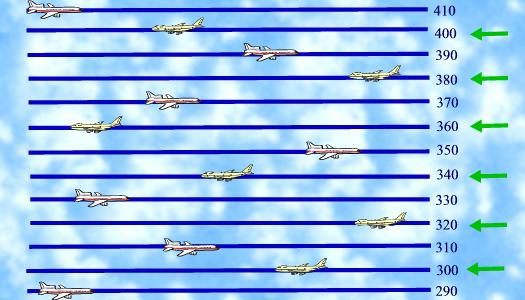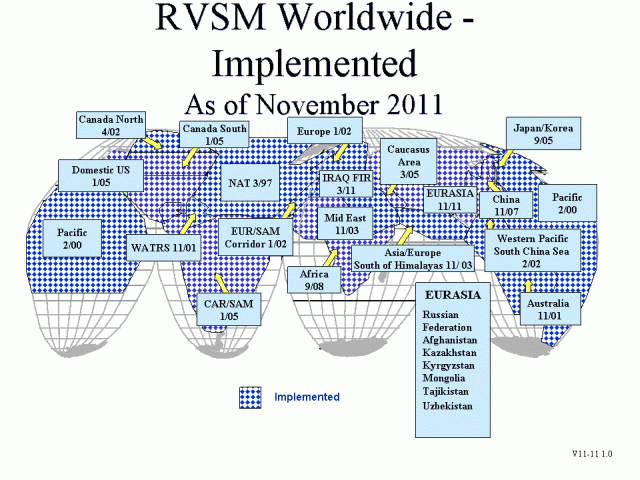
|
HANKE-Aviation GmbH - Flight Crew Training |
|
Introduction to RVSM |
CHAPTER 1
A
RVSM airspace is defined as any airspace or route where the aircraft are
separated vertically by 1000ft between FL 290 and FL 410 inclusive (instead of
2000ft).
The
objective is to increase the route capacity of saturated airspace while keeping
at least the same level of safety. This can be achieved in imposing stringent
requirements on equipment and training of personnel, flight crews and ATC
controllers. As part of the RVSM program, the altitude keeping performance of
the aircraft is monitored, overhead specific ground based measurement units, to
continuously verify that airspace users are applying the approved criteria
effectively and that the overall safety objectives are maintained.
The
concept was first implemented in the NAT MNPS area and associated airspace, from
FL 330 to FL370 inclusive, starting in March 1997 and fully implemented in
January 1998. RVSM airspace expansion is planned in the NAT region and may
include FL 310 and FL390 by the end of 1998. In 1998, 90 % of NAT MNPS
operations are conducted with RVSM approved aircraft and 75% use FL 330 to 370.
Since its start, the RVSM concept has been validated; the altitude keeping
performance of the aircraft monitored by the Height Monitoring Units (HMU) of
Gander and Strumble indicated that the safety objectives are met.
The
NAT RVSM operational experience has shown some cases of spurious TCAS messages
cases of wake vortex encounter.
The
few reported occurrences were considered as being not critical. Next generation
of TCAS will solve the TCAS events and spacing or offset track under specific
weather conditions will reduce the vortex encounters.
A Reduced Vertical Separation Minimum (RVSM) of 300m (1000ft) separation between aircraft was introduced on 24 January 2002 by 41 European and North African countries.
RVSM provides six additional
cruising levels between FL 290 and FL 410, resulting in substantial reductions
in fuel costs and in-flight delays.


RVSM Area of Applicability [extract from the ICAO Regional Supplementary Procedures for Europe (Doc 7030/4 EUR)]
RVSM is applied in the volume of airspace between FL290 and FL410 inclusive in the following flight information regions/upper flight information regions (FIRs/UIRs):
RVSM Status Americas - Europe North Atlantic: March 27, 1997 FL 330-370 October 1998 FL 310-390 Jan 24, 2002 FL 290-410 West Atltanic Rt Syst (WATRS): Nov 1, 2001 FL 310-390 24 January 2002 FL 290-410 Europe Tactical (UK, Ireland,Germany, Austria) April 2001 FL 290-410 Europe-wide 24 January 2002 FL 290-410 South Atlantic: 24 January 2002 FL 290-410 Canada Northern Domestic 18 April 2002 FL 290-410 Canada Southern Domestic January 20, 2005 FL 290-410 Domestic US January 20, 2005 FL 290-410 Caribbean/Central/South America January 20, 2005 Consult AIPs
RVSM Status Asia/Pacific Pacific: February 24, 2000 FL 290-390 *FL 410 is available for non-RVSM approved flights Tactical Use FL 400-410 Australia: November 2001 FL 290-410 Western Pacific/South China Sea Feb 21, 2002 Consult AIPs Mid East: November 2003 Consult AIPs Asia-Europe/South of Himalayas: November 2003 Consult AIPs
RVSM Status Asia/Pacific Eurasia: November 17, 2011 Consult AIPS Russian Federation: November 17, 2011 FL 290-410 Afghanistan November 17, 2012 FL 290-410 Kazakhstan: November 17,2011 FL 290-410 Kyrgyzstan: November 17,2012 FL 290-410 Mongolia: November 17,2011 FL 290-410 Tajikistann: November 17,2011 FL 290-410 Uzbekistan: November 17, 2011 FL 290-410
|
AAD |
Assigned
Altitude Deviation |
|
ACAS |
Airborne
Collision Avoidance System |
|
ACC |
Area
Control Centre |
|
ADC |
Air
Data Computer |
|
ADR |
Air
Data Reference |
|
AFM |
Airplane
Flight Manual |
|
AMC |
Airspace
Management Cell |
|
AOC |
Air
Operators Certificate |
|
AP |
Autopilot |
|
ASE |
Altimetry
System Error |
|
ATC |
Air
Traffic Control |
|
ATM |
Air
Traffic Management |
|
ATS |
Air
Traffic Services |
|
BRNAV |
Basic
Area Navigation |
|
CBT |
Computer
Based Training |
|
CFL |
Cleared
Flight Level |
|
CFMU |
Eurocontrol
Central Flow Management Unit |
|
CMA |
Central
Monitoring Agency |
|
CNS |
Communication,
Navigation and Surveillance |
|
CRM |
Collision
Risk Model |
|
CTA |
Control
Area |
|
CVSM |
Conventional
Vertical Separation Minima |
|
DMC |
Display
Management Computer |
|
EANPG |
European
Air Navigation Planning Group |
|
EATCHIP |
European
Air Traffic Control Harmonization and Integration Program |
|
ECAC |
European
Civil Aviation Conference |
|
FCOM |
Flight
Crew Operating Manual |
|
FCU |
Flight
Control Unit |
|
FDPS |
Flight
Data Processing System |
|
FIR |
Flight
Information Region |
|
FL |
Flight
Level |
|
FLAS |
Flight
Level Allocation Scheme |
|
FM |
Flight
Management |
|
FMS |
Flight
Management System |
|
FPL |
Filed
Flight Plan |
|
FTE |
Flight
Technical Error |
|
FWC |
Flight
Warning Computer |
|
GMS |
Global
Positioning System Monitoring System |
|
GMU |
Global
Positioning System Monitoring Unit |
|
GNE |
Gross
Navigational Error |
|
GPS |
Global
Positioning System |
|
GPWS |
Ground
Proximity Warning System |
|
HF |
High
Frequency |
|
HMU |
Height
Monitoring Unit |
|
IFPS |
Integrated
Initial Flight Plan Processing System |
|
IRS |
Inertial
Reference System |
|
JAA |
Joint
Aviation Authorities |
|
MASPS |
Minimum
Aircraft System Performance Specification |
|
MEL |
Minimum
Equipment List |
|
MMEL |
Master
Minimum Equipment List |
|
MNPS |
Minimum
Navigation Performance Specification |
|
MOS |
Minimum Operating Standard |
|
NAT |
North Atlantic |
|
NAT CMA |
North Atlantic Central
Monitoring Agency |
|
NAT SPG |
North Atlantic Systems
Planning Group |
|
OAC |
Oceanic Area Control Center |
|
OCA |
Oceanic Control Area |
|
OCC |
Operations Control Center |
|
OM |
Operations Manual (Parts A,
B, C, D) |
|
OTS |
Organized Track System |
|
PFD |
Primary Flight Display |
|
PTS |
Polar Track Structure |
|
RA |
Resolution Advisory (ACAS) |
|
RFL |
Requested Flight Level |
|
RNAV |
Area Navigation |
|
RNP |
Required Navigation
Performance |
|
RTA |
Reduced Vertical Separation
Minimum Transition Area |
|
RTF |
Radiotelephony |
|
RVSM |
Reduced Vertical Separation
Minimum of 300 m (1000 ft) between FL 290 and FL 410 inclusive. |
|
SB |
Service Bulletin |
|
SD |
Standard Deviation |
|
SSEC |
Static Source Error
Correction |
|
SSR |
Secondary Surveillance Radar |
|
SST |
Supersonic Transport |
|
TA |
Traffic Advisory (ACAS) |
|
TCAS |
Traffic Alert and Collision
Avoidance System |
|
TGL |
Temporary Guidance Leaflet |
|
TLS |
Target Level of Safety |
|
TSA |
Temporary Segregated Area |
|
TSE |
Total System Error |
|
TVE |
Total Vertical Error |
|
UAC |
Upper Area Control Center |
|
UIR |
Upper Flight Information
Region |
|
VSM |
Vertical Separation Minimum |
Information on all aspects of the European RVSM program is available through the Internet by addressing the EUROCONTROL RVSM Web site:
Additional Information for the RVSM Approval Process is provided by the LBA RVSM-Merkblatt (german).
(c) M.Hanke 2014